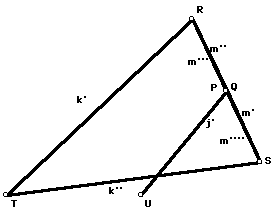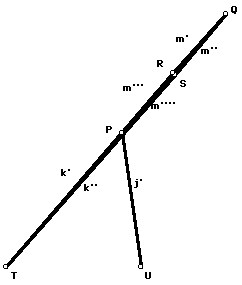Next: Epilogue
Up: Peaucellier's Linkage Table of Contents
Prev: Construct the Linkage
Peaucellier's Linkage
Part 3. Another look at the Linkage
A. The linkage and inversion
Now that you have investigated inversion, look again at the
linkage discussed previously.
- Comparing the chart you made in the section on inversion, to the
shapes traced out by P and Q, is it possible that P and Q are related
by inversion?
- If so, where would P, Q, and the center of the circle of inversion
all lie? What other property would P, Q, and the center of the circle
satisfy?
- Find a point on the linkage that satisfies these properties as P
moves around the circle. (Hint: You may want to use the Calculator on
the Measure menu to measure a product. What has to be true of this
constant as P moves?)
- Once you have found the point satisfying the definition, points P
and Q must be inverses through some circle of inversion. Therefore
from your chart, you know the shape that Q traces. However, go on and
actually find the circle of inversion and construct the path traced by
Q as follows.
B. Constructing the circle of inversion
Using your product, you know the radius of the center of inversion.
What is it? Although you know it, since it is a measured quantity,
you need to find it in another way in order to construct the circle of
inversion: Since the radius is a constant independent of the position
of the linkage, it depends only on the three fixed length segments you
made off to the side. What is the relationship? This is a pen and
paper exercise using the Pythagorean theorem. Here are some pictures
of specific cases to help you form a conjecture for a general equation
for the radius of the circle of inversion. In the first
picture, P and Q lie on top of each other. In the second, R and S lie
on top of each other. In each case, can you state the radius of the
circle of inversion in terms of the segments j, k, and m?


Finally, use the circle of inversion you constructed and your method
for constructing the inverse of a circle to construct the shape traced
by Q. Check that Q does lie on this shape as you move P.
Next: Epilogue
Up: Peaucellier's Linkage Table of Contents
Prev: Construct the Linkage
![[HOME]](/pix/home.gif) The Geometry Center Home Page
The Geometry Center Home Page
Author: Evelyn Sander
Comments to:
webmaster@www.geom.uiuc.edu
Created: Jun 09 1996 ---
Last modified: Jun 11 1996




![[HOME]](/pix/home.gif) The Geometry Center Home Page
The Geometry Center Home Page